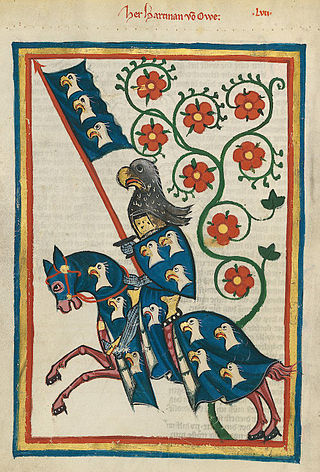
A knight is a person granted an honorary title of knighthood by a head of state or representative for service to the monarch, the church or the country, especially in a military capacity.

Chivalry, or the chivalric language, is an informal and varying code of conduct developed in Europe between 1170 and 1220. It is associated with the medieval Christian institution of knighthood, with knights being members of various chivalric orders, and with knights' and gentlemen's behaviours which were governed by chivalrous social codes. The ideals of chivalry were popularized in medieval literature, particularly the literary cycles known as the Matter of France, relating to the legendary companions of Charlemagne and his men-at-arms, the paladins, and the Matter of Britain, informed by Geoffrey of Monmouth's Historia Regum Britanniae, written in the 1130s, which popularized the legend of King Arthur and his knights of the Round Table.

Amadeus VI, nicknamed the Green Count was Count of Savoy from 1343 to 1383. He was the eldest son of Aymon, Count of Savoy, and Yolande Palaeologina of Montferrat. Though he started under a regency, he showed himself to be a forceful leader, continuing Savoy's emergence as a power in Europe politically and militarily. He participated in a crusade against the Turks who were moving into Europe.
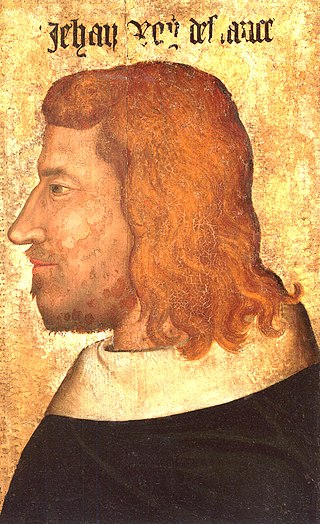
John II, called John the Good, was King of France from 1350 until his death in 1364. When he came to power, France faced several disasters: the Black Death, which killed between a third and a half of its population; popular revolts known as Jacqueries; free companies of routiers who plundered the country; and English aggression that resulted in catastrophic military losses, including the Battle of Poitiers of 1356, in which John was captured.

The King's Daughters were the approximately 800 young French women who immigrated to New France between 1663 and 1673 as part of a program sponsored by King Louis XIV. The program was designed to boost New France's population both by encouraging Frenchmen to move to the New World, and by promoting marriage, family formation, and the birth of French children in the colony. The term refers to those women and girls who were recruited by the government and whose travel to the colony was paid for by the king. They were also occasionally known as the King's Wards.
This article contains information about the literary events and publications of 14th century.

The Knights of the Round Table are the legendary knights of the fellowship of King Arthur that first appeared in the Matter of Britain literature in the mid-12th century. The Knights are an order dedicated to ensuring the peace of Arthur's kingdom following an early warring period, entrusted in later years to undergo a mystical quest for the Holy Grail. The Round Table at which they meet is a symbol of the equality of its members, who range from sovereign royals to minor nobles.

George was king of Saxony and member of the House of Wettin.

Fulk III, the Black was an early Count of Anjou celebrated as one of the first great builders of medieval castles. It is estimated Fulk constructed approximately 100 castles as well as abbeys throughout the Loire Valley in what is now France. He fought successive wars with neighbors in Brittany, Blois, Poitou and Aquitaine and made four pilgrimages to Jerusalem during the course of his life. He had two wives and three children.
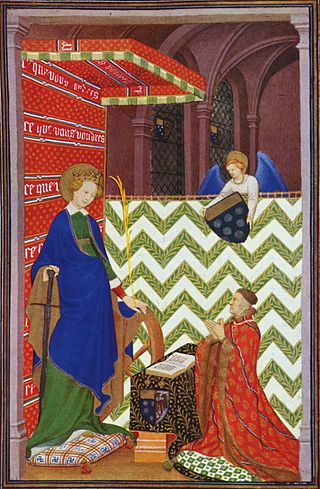
Jean II Le Maingre, also known as Boucicaut, was a French knight and military leader. Renowned for his military skill and embodiment of chivalry, he was made a marshal of France.

Louis Marchand was a French organist, harpsichordist and composer. Born into an organist's family, Marchand was a child prodigy and quickly established himself as one of the best known French virtuosos of his time. He worked as organist of numerous churches and, for a few years, as one of the four organistes du roy. Marchand had a violent temperament and an arrogant personality, and his life was filled with scandals, publicized and widely discussed both during his lifetime and after his death. Despite his fame, few of his works survive to this day, and those that do almost all date from his early years. Nevertheless, a few pieces of his, such as the organ pieces Grand dialogue and Fond d'orgue have been lauded as classic works of the French organ school.
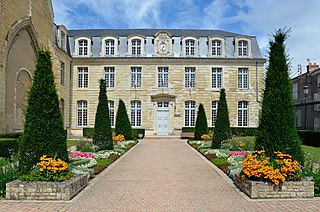
Thouars is a commune in the Deux-Sèvres department in western France. On 1 January 2019, the former communes Mauzé-Thouarsais, Missé and Sainte-Radegonde were merged into Thouars.
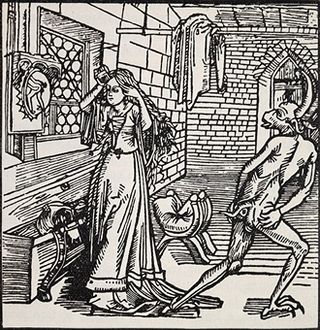
The Book of the Knight of the Tower is a book commenced by Geoffroy IV de la Tour Landry in 1371, and which he continued writing at least until 1372. It was translated into English by William Caxton and completed, according to his colophon, on 1 June 1483, during the reign of Edward V. It was further translated into German as Der Ritter vom Turn in 1493. The Livre pour l'enseignement de ses filles served as a tutorial for De la Tour Landry's daughters on proper behavior when visiting the royal court, which, the knight warns, is filled with smooth-talking courtiers who could potentially disgrace them and embarrass the family. The author was a widower, and concerned for his daughters' welfare. He takes a strong moral stance against the behavior of his peers and warns his daughters about the dangers of vanity.
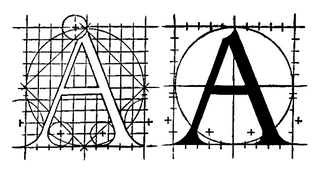
GeoffroyTory was a French humanist and an engraver, best known for adding accents on letters in French. His life's work has heavily influenced French publishing to this day.
Sir Nicholas Brembre was a wealthy magnate and a chief ally of King Richard II in 14th-century England. He was Lord Mayor of London in 1377, and again from 1384–5,6. Named a "worthie and puissant man of the city" by Richard Grafton, he became a citizen and grocer of London, and in 1372-3 purchased from the Malmains family the estates of Mereworth, Maplescomb, and West Peckham, in Kent. His ties to Richard ultimately resulted in his downfall, as the anti-Richard Lords Appellant effectively took control of the government and imprisoned, exiled, or executed most of Richard's court. Despite Richard's efforts, Brembre was executed in 1388 for treason at the behest of the Lords Appellant.
Landry is a surname of French origin. Landry appears in the names of towns in France, Canada and the United States, as well as three canonized saints.

Pontus and Sidonia is a medieval prose romance, originally composed in French in ca. 1400, possibly by Geoffroy IV de la Tour Landry or by another member of the La Tour family. It is about Pontus, the son of the king of Galicia, who falls in love with Sidonia, daughter of the king of Brittany. The text is associated with the lords of La Tour because it derives the ancestors of that family, whose ancestral possessions were in Brittany, from members of the train of prince Pontus. The story is based on an earlier work, the Anglo-Norman chanson de geste Horn et Rimenhild.
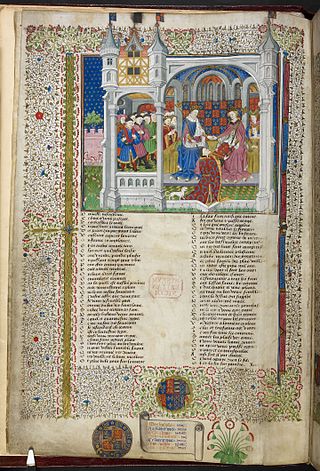
The Talbot Shrewsbury Book is a very large richly-illuminated manuscript made in Rouen (Normandy) in 1444/5. It was presented by John Talbot, 1st Earl of Shrewsbury to the French princess, Margaret of Anjou, in honour of her betrothal to King Henry VI. It contains a unique collection of fifteen texts in French, including chansons de geste, chivalric romances, treatises on warfare and chivalry, and finally the Statutes of the Order of the Garter. The work is an excellent example of book production in Rouen in the mid-fifteenth century and provides a rare insight into the political views of the English military leader and close confidant of the crown, John Talbot.
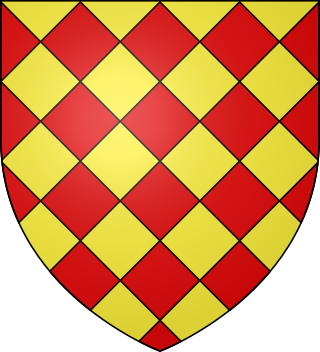
Amaury IV of Craon, Lord of Craon, Chantocé, Ingrandes, Briollé, Châteauneuf-sur-Sarthe, Précigné and Sablé, Sainte-Maure, Nouâtre, Pressigny and Marcillac, Châteauneuf-sur-Charente and Jarnac, was a French noble, who was part of the Hundred Years' War.
Oton III de Grandson, name also spelled Otto, Othon, etc., was a nobleman, soldier, and poet in fourteenth century France. Although his military service was primarily to the King of England, his reputation for chivalry and poetry was renowned throughout Europe.

















